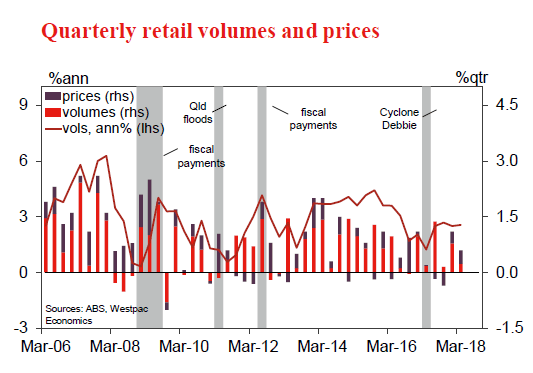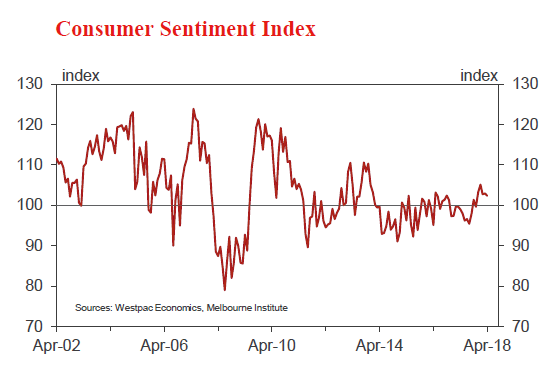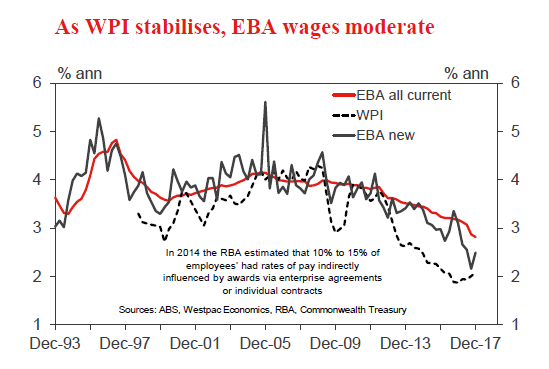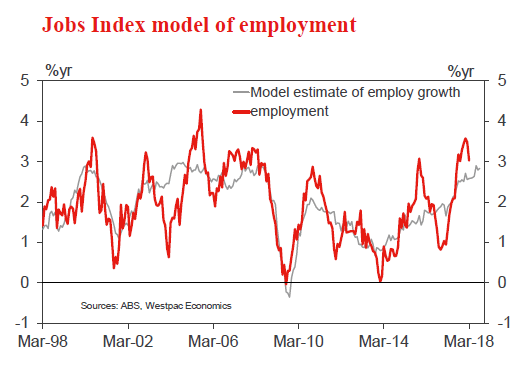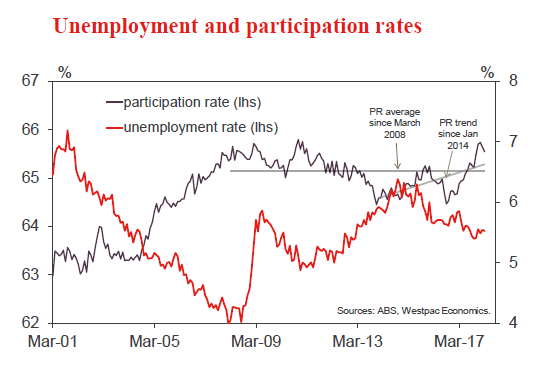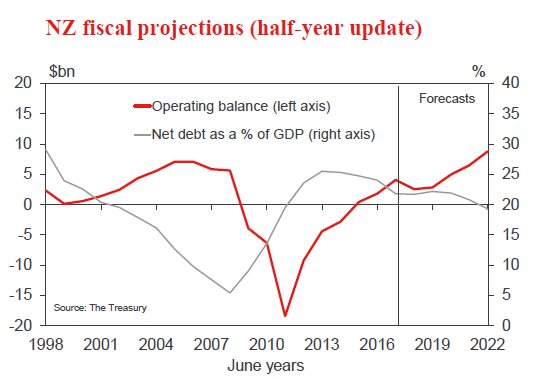Week beginning 14 May 2018
- Federal Budget 2018: an improved budget position, but downside risks remain.
- RBA: RBA minutes, Deputy Governor Debelle speaks.
- Australia: Wage price index, employment, Westpac-MI consumer sentiment.
- NZ: Federal Budget.
- China: retail sales, industrial production, fixed asset investment.
- Euro Area: GDP 2nd estimate.
- US: retail sales, Fed nominees testify before senate.
- Key economic & financial forecasts.
Information contained in this report current as at 11 May 2018.
Federal Budget 2018: An Improved Budget Position, but Downside Risks Remain
The Federal Treasurer delivered Budget 2018 on May 8. This was the second and likely last annual budget of this parliament prior to the next Federal election, which is due no later than 18 May 2019.
The backdrop to this years’ budget is an improvement in the fiscal position relative to that expected by the Government in the December Mid-Year Economic and Fiscal Outlook (MYEFO). This is a welcome change from recent years, when the revenue profile was typically revised lower. A key development contributing to this change in fortune relates to commodity prices, which having fallen to historic lows at the end of calendar 2015 have rebounded and proven to be more resilient than anticipated.
Key themes for Budget 2018 are described by the Government as tax relief, which is to be phased in over a number of years, as well as progressively rolling out infrastructure spending in the context of the $75bn in initiatives over the next decade.
The Government is now forecasting the budget to improve from a deficit of 1.9% of GDP in 2016/17, to a deficit of 1.0% of GDP this financial year, narrowing a little to a deficit of 0.8% of GDP in 2018/19 (at $14.5bn), then moving to a small surplus in 2019/20, with the surplus widening to a forecast 0.8% of GDP in 2021/22.
Over the five years to 2021/22, the budget position improves by 2.7ppts of GDP. As with before, the improvement is centred on an expected lift in revenues. Total revenue increases from 23.3% of GDP in 2016/17 to a likely 24.3% this year and then lifts to 25.5% by 2021/22, an increase of 2.2ppts over the period. Total payments are little changed, edging down from 25.0% in 2016/17 to 24.7% in 2021/22.
Relative to MYEFO, the budget position has improved: by $5.4bn in 2017/18 to -$18.2bn; by $6.0bn in 2018/19 to -$14.5bn; by $4.8bn in 2019/20 to +$2.2bn; and improved by only $0.8bn in 2020/21 to $11.0bn; while the surplus is forecast to widen to $16.6bn in 2021/22, the additional year that rolls into the budget period. The timing of the return to surplus has been brought forward by a year, to 2019/20, to a forecast +$2.2bn from a forecast -$2.6bn.
In 2017/18, the Australian economy has been more resilient than anticipated, underpinning the improved budget position. Income growth, or nominal GDP, is now expected to be 4.25% this year, upgraded by 0.75ppts on MYEFO, reflecting upside on commodity prices, output and jobs growth. Note that nominal GDP growth of 4.25% is still well below the long run average of 5.6% and represents a slowing from a 5.9% outcome in 2016/17.
Nominal GDP growth over the 3 years from 2018/19 is expected to be: 3.75% (with the terms of trade -5.25%); 4.75% (tot -2.25%); and 4.50% (tot forecast is not provided); broadly in line with that in MYEFO. The Budget continues to anticipate that output growth lifts to a little above trend pace of 3.0% in 2018/19, with growth sustained at this rate across the forecast horizon.
The boost to the bottom line from the stronger economy is an estimated $7.0bn in 2017/18, with only a partial offset of $1.6bn from the net cost of new policy measures. Across the four years to 2020/21, the stronger economy boosts the budget by $27.8bn and the net cost of policy measures is $10.7bn. Hence, the expected cumulative budget deficit over the four years to 2020/21 is now some $17bn lower than expected in MYEFO, at a forecast $19.5bn.
Forecast tax receipts due to the stronger economy are $7.0bn higher in 2017/18 and increase by $25.8bn over the four years to 2020/21. This upside surprise on tax receipts includes: gross income tax up by $13bn, boosted by stronger jobs growth; and company taxes $3.7bn higher than anticipated, reflecting the impact of more resilient commodity prices.
The Commonwealth Government’s net debt position remains manageable and the profile is now lower than previously expected reflecting the improved budget position.
Net debt lifts from an estimated 18.3% of GDP ($322bn) in 2016/17 to a peak, as a share of the economy, of 18.6% of GDP ($341bn) in 2017/18. In MYEFO, net debt peaked at 19.2% of GDP in 2018/19. In coming years, debt levels are expected to decline in dollar terms, to $334bn at June 2021, some $21bn lower than in MYEFO, and then falling to $319bn, 14.7% of GDP, at June 2022.
Net interest payments moderate over the forecast horizon, consistent with the profile of declining debt. Net interest payments moderate from an estimated $14.5bn, 0.8% of GDP, in 2018/19 to 0.6% of GDP in 2021/22. As to gross debt, this rises from $501bn (28.5% of GDP), in 2016/17, to $561bn, 29.5% of GDP, in 2018/19, before moderating as a share of the economy to 26.6% in 2021/22, at $578bn.
The Budget also focuses on medium-term projections. Consistent with past years, the approach to forecasting beyond the initial two year period is to assume that real GDP growth is 3.0%, which is a little above trend, with trend judged to be 2.75%, such that spare capacity in the economy is gradually absorbed. By the end of 2024/25 spare capacity is absorbed and real GDP is projected to grow at its potential rate thereafter. The unemployment rate is projected to converge to 5% over the medium-term, inflation is 2.5%, the mid-point of the RBA’s target band, and the terms of trade remain flat at around their 2005 level from 2020/21.
The surplus is projected to reach 1.8% of GDP in 2028/29 in the absence of a cap on the tax share of GDP, with the cap set at 23.9%. By contrast, if tax is capped at 23.9%, the surplus reaches only a little above 1% of GDP from 2026/27.
In terms of policy decisions, the focus is on personal income tax relief. This begins in 2018/19, at a cost of only $0.4bn in that year, lifting to a $4.1bn cost in 2019/20, with a four year impact of $13.4bn. However, the net impact of policy decisions on tax receipts is $7.2bn over the four year with partial offsets from increased compliance measures and a crack-down on the ‘black economy’. Beyond this period, the personal income tax plan is progressively implemented over the medium-term, with measures impacting in 2022/23 and in 2024/25. In the absence of the tax plan, it is projected that tax receipts would exceed 23.9% of GDP from 2021/22.
Over the near-term, the direct impact on the economy of Budget 2018 is negligible. The key point is that the net impact of new policy decisions is only $0.6bn in 2018/19, increasing a little to $1.5bn in 2019/20, before climbing to a more sizeable $6.9bn in 2020/21 and $5.7bn in 2021/22.
As to risks around the budget position, the experience of the past couple of years is that risks have receded somewhat as commodity prices proved to be more resilient than anticipated and jobs growth surprised to the high side, contributing to the improved budget position in this update.
Going forward, the risk remains that the economic forecasts are too optimistic. Notably, real output growth is expected to lift to above trend in 2018/19 and to hold at this pace until the output gap is closed out in 2024/25, after which growth settles back to a trend pace. Westpac Economics is less upbeat on growth prospects for 2018/19 and 2019/20, forecasting real GDP growth of 2.5% and 2.6%, with a view that consumer spending will be constrained by sluggish wages growth and as the housing sector cools. As to the medium-term view, over such an extended time horizon the risk of a period of sub-trend growth due to either a domestic or external shock is very real.
The week that was
This week, all eyes were on Budget 2018 and the subsequent reply from opposition leader Bill Shorten. The latter receiving greater attention than usual given this is the last Budget before the next Federal election – due by May 2019.
For the Government, the focus was tax reform; infrastructure; health and aged care made possible by a much-improved starting position, thanks to strong employment growth in 2017 and elevated commodity prices. All of the detail of the Budget can be found in the essay above, our video and a written summary.
The point to make with respect to Labor’s reply is that the political debate for the coming year is shaping up around tax, particularly for low-to-middle income workers, as well as health and education – as you would expect. Whether the initial part of the Government’s proposed tax reform will be passed by the next election will depend on if they break up their package into components or not. At present, they are unwilling to do so. More broadly on the Budget, our concern over the return to surplus is that it is built upon a sharp acceleration in wages growth, from 2.0%yr to 3.25%yr in two years, then to 3.50%yr the year after. To us, that seems unlikely, limiting the Government’s capacity to deliver reform as planned.
Away from the Budget, there were two key data releases for Australia this week. First came another very strong result for the NAB business survey. In April, business conditions were reported to be at a historic high, with business confidence also well above average. For conditions, trading conditions; profitability and employment all moved higher from already elevated levels. Sentiment towards investment also remains constructive, albeit concentrated in construction. Importantly, the strength reported in conditions and confidence is broad based across the nation.
Of greater significance for the growth outlook however, retail sales in March were a material disappointment, signalling clear downside risks to consumption growth in the March quarter. See chart of the week below.
Overseas, the RBNZ met this week. Their May Monetary Policy Statement showed that the Bank is on hold for the foreseeable future, as long expected by our NZ economics team. The ‘shake up’ in form and language however came as a surprise to many in the market, with the NZD/USD falling around 1%. Inflation continues to stubbornly hold well below the 2.0% target, principally due to very low tradeables inflation. However, employment is viewed as near its maximum sustainable level. This then is justification not to cut rates further, but rather hold them at the current accommodative level for a protracted period. Our NZ economics team continue to see the first hike as likely to come in November 2019.
Over in the UK, the Bank of England held to a positive albeit cautious stance in May, with a 7-2 vote in favour of leaving the Bank Rate unchanged. Interestingly, the Bank believe that the poor March quarter GDP outcome of 0.1% is likely to be revised up, in opposition to the statistics agency. That said, their 2018 growth forecast has been revised down to 1.4%yr, from 1.75%yr in February, and 1.5%yr before that. Concern over inflation has also been alleviated somewhat by it retracing towards target quicker than anticipated, with the 2018 forecast revised down from 2.7%yr to 2.4%yr.
We recently revised our interest rate view for the UK from two hikes to end 2019 to none. We have been concerned over the state of the economy for some time, and downside risks look to be crystallising. Consistent with this view, the strong resolve of the Governor and Committee to actively rein in inflation to the 2.0%yr target looks to be dissipating.
Finally on the US, it has been an interesting week. The US 10yr yield has increasingly looked comfortable near 3.00%, as belief in continued rate hikes by the FOMC through 2018 and 2019 became more entrenched. Interestingly this has occurred despite further evidence of a distinct lack of wage and inflation pressures.
In the employment report, monthly growth in hourly earnings remained benign at 0.2% for a fourth month, showing no sign of an acceleration. In annualised terms, given headline CPI inflation is at a similar level, that implies real wages are flat. This is despite continued employment growth well in excess of population growth, and an unemployment rate at 3.9% – below its fullemployment level. Participation by prime-aged workers can rise further, so it is our view that wage pressures are still a way off.
On the CPI, overnight both the headline and core measures disappointed market expectations in April. Notably, the threemonth annualised pace of core CPI inflation has now decelerated to 1.8%, below the FOMC’s target. Clearly for the FOMC, there is no need for any urgency with policy.
Chart of the week: Q1 retail sales volumes
The March retail report was a disappointing update that came in materially below expectations. Nominal sales posted a 0.6%qtr rise, but adjusting for prices, retail volumes rose just 0.2%qtr, well below the consensus expectation of a 0.5% gain.
The detail on retail volumes shows basic food retail rebounded 0.7%qtr from a 1.2% fall in Q4, but weaker quarter to quarter reads across almost all other store-type categories with department store sales volumes stalling flat and cafes & restaurants contracting 0.4%qtr. Online sales continue to outpace total retail with the online share rising to a new high of 5.3% in March.
Overall, the downside surprise for Q1 real retail sales clearly points to downside risks to the wider measures of consumer spending in the Q1 national accounts due out on June 6. That said, much of the weakness appears to reflect specific challenges facing the retail sector with business surveys suggesting consumer spending on services has been firmer.
New Zealand: week ahead & data wrap
The Reserve Bank served up a refreshing Monetary Policy Statement (MPS) under new Governor Adrian Orr, with straightforward language and an infographic. Beneath those cosmetic changes the outlook for the OCR was very similar to the outlook given in February – the OCR is on hold for a considerable period.
There was perhaps the slightest hint of a shift in a dovish direction. The reminder that the next move in the OCR could be either “up or down” was brought right up front in the document. And the actual OCR forecast was the barest shade lower (a tenth of a percent lower in a single quarter). Markets reacted strongly to that, and the New Zealand dollar fell nearly a cent over the day.
The RBNZ and financial markets are continuing to move incrementally closer to our view that a slowing economy might make it very difficult to boost inflation, and consequently the OCR will not need to rise until the end of 2019.
The most interesting aspect of the MPS was the RBNZ’s treatment of its new employment mandate. The RBNZ came right out and stated that employment is currently roughly at its maximum sustainable level. That took guts – the Government will be displeased at the implication that its goal of 4% unemployment is currently viewed as unsustainable.
The RBNZ went through a range of ways to measure where employment is relative to the sustainable maximum, but sounded most enthusiastic about the most obvious one – the unemployment rate. The RBNZ also placed a lot of weight on wage growth as an indicator of where the labour market is in the cycle. Wage growth has undershot forecasts for years, and if it continues to do so the RBNZ might conclude that employment has not reached its maximum sustainable level after all. Low wage growth would also portend low inflation, so the outlook for wage growth now has double significance for the RBNZ.
The other interesting feature of the MPS was the lack of discussion around the exchange rate and the housing market. We view that as an improvement, particularly with regards to the exchange rate. The RBNZ has a long history of obsessing over the exchange rate and engaging in fruitless attempts to jawbone it lower. At best this has diverted attention from issues monetary policy can actually influence, and at worst it has led to serious monetary policy errors.
The other key development over the past week has been a rash of weak household-related data for April. Electronic card transactions and car registrations fell very sharply, and housing market data was weak.
The New Zealand housing market cooled over the first half of 2017, but enjoyed something of a comeback from September last year. The latest data have confirmed that the brief resurgence is over, and the New Zealand housing market is cooling once more. Market turnover is down, house prices are now falling in Northern New Zealand, and the rate of house price inflation has slowed elsewhere, most notably in Wellington.
This is bang on what we were expecting. We have long been forecasting a modest decline in house prices due to a raft of expected law changes. The first of these was the extension of the Bright Line Test, introduced at the end of March. Property investors must now hold a property for five years before selling if they want to avoid being taxed on capital gains. Later this year we will see a foreign buyer ban come into force, and next year property investors’ ability to claim tax deductions on rental property losses will be phased out. Finally, later this year the Tax Working Group will report back, and will probably recommend further taxes on property. We would be stunned if these changes failed to dent house prices.
If the housing market does weaken in the way we anticipate, there will be two main consequences. First, the Reserve Bank will become more willing to loosen its mortgage lending restrictions, which were already loosened slightly in January. We are looking for a second loosening in November this year, but an earlier move cannot be ruled out. We may get more guidance when the next Financial Stability Review is released on 31 May. And second, a weaker housing market will shift the balance of monetary policy in a dovish direction.
Next week, the new coalition Government will release its first Budget. The Budget will probably be fairly mundane in terms of new policy announcements, at least compared to the half-year update last December. We expect the Government will stick to its forecast for a gradual decline in the net debt to GDP ratio, and therefore the forecasts for the bond programme will also stay the same. We will provide a full preview of the Budget next week.
The Government may well forecast a reduction in debt relative to GDP below 20%, but there has been much discussion about whether this goal will actually be achieved in reality. This week we published a bulletin1 explaining why we think the answer is a resounding yes. First of all, with the tax take exceeding forecasts recently, 20% net debt to GDP is not going to be all that difficult to achieve. But more importantly, even if the Government overspends on operational spending, it is highly likely to underspend its capital budget. The Government is forecasting a near-doubling of capital spending within two years. We seriously doubt they will be able to get that much investment done, given how capacity constrained the construction sector is. Less investment would also mean less debt. We have concluded that the Government will easily meet its debt target, but it might be for the wrong reasons.
Data Previews
Aus May Westpac-MI Consumer Sentiment
- May 16, Last: 102.4
After a promising start to the year, sentiment has drifted lower over the last three months, the index slipping to 102.4 in April. While still over the ‘gain line’ – reads above 100 indicate optimists still outnumber pessimists – and more encouraging than through most of 2017, the index remains well below the 105-115 levels typically associated with a robust consumer.
The May survey is delayed a week in order to capture reactions to the Federal budget. Aside from this, sentiment may also be affected by financial market moves, the ASX200 rebounding strongly to be up 5.5% since the April survey but the AUD sliding nearly 2½¢ USD. Petrol prices have also shown a notable lift, average pump prices up over 7¢ a litre nationally since the last survey and over 13¢ since early March. Continued slippage in Sydney and Melbourne house prices is also likely to be weighing on sentiment.
Aus Q1 Wage Price Index
- May 16, Last 0.6%, WBC f/c: 0.6%
- Mkt f/c: 0.6%, Range: 0.5% to 0.7%
There has been some tightening in the Australian labour market, as measured by the broader measures of labour utilisation, but we still observe ongoing weakness in wage outcomes. Total hourly wages ex bonuses increased 0.6% in the December quarter, just slightly above market and Westpac expectations for 0.5% lifting the annual pace modestly from 2.0%yr to 2.1%yr.
Private sector wages grew 0.5% holding the annual rate at 1.9%yr. Public sector wages grew 0.6% with the boost coming from professional & technical (1.0%), education (0.8%) and health care (0.9%). Public sector wage inflation is holding an annual pace of 2.4%yr which is just up on the 2016 record low of 2.3%yr.
The December quarter reported a modest uptick in new Enterprise Bargaining Agreements wage outcomes, but they are still less than the average of existing agreements.
Aus April Labour Force – total employment ‘000
- May 17, Last 4.9k, WBC f/c: 17
- Mkt f/c: 20, Range: 10 to 30
Australian employment grew just 4.9k in March but just as significant, the 17.5k gain in February was revised to -6.3k. The ABS now tells us that February was the first negative print in a record breaking run of 16 consecutive monthly gains. This was a bit of an anti-climax for what should have been a quite momentous occasion.
A run of weak numbers were to be expected. After all the upswing in employment through the second half of 2017 was well above what our broader leading indicators were suggesting. The three month average gain has fallen from 45.7k in January to 12.0k in March while the annual pace of growth has eased back to 3.0% from 3.6% in January.
Our analysis of the various business surveys suggests employment growth of something closer to 2¾%yr. Our 17k forecast for April will see the annual rate ease back to 2.8%.
Aus April Labour Force – unemployment rate %
- May 17, Last 5.5%, WBC f/c: 5.5%
- Mkt f/c: 5.5%, Range: 5.3% to 5.6%
Despite weak employment the unemployment rate was flat at 5.5%, which had been revised down from 5.6%. The participation rate was 65.5% down from February’s figure of 65.6%.
It appears that the unemployment rate has at least flattened so far in 2018, or can even be described as rising a little with a March quarter average of 5.52% vs. 5.45% in the December quarter. We also noted that the participation rate has drifted down a little but it is not far off the recent record high.
We estimate the participation rate will round up from 65.5% in March to 65.6% in April resulting in a 17k lift in the labour force. As this matches our 17k forecast gain in total employment, the unemployment rate holds flat at 5.5.
We should note given just how high the participation rate is, it is possible we will see a lower unemployment rate due to a further fall in participation.
NZ Budget 2018
- May 17
When the Government delivers its first Budget next week it will walk the tightrope between increased spending and keeping within its Budget Responsibility Rules. While operational spending is likely to increase, thanks to a higher than expected tax take in recent months, the Budget projections will be constrained by reducing net core crown debt below 20% of GDP by 2021, and continuing to project operating surpluses.
It will have been helped by a strong starting point, with the tax take currently running around $1.1 billion ahead of forecast.
The Government has signalled net capital spending plans over the next five years are broadly unchanged from those presented in December’s Half Year Fiscal Update.




